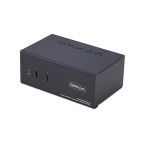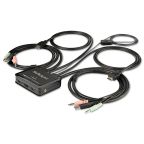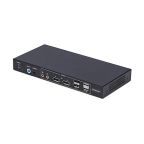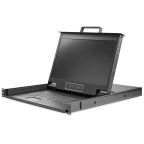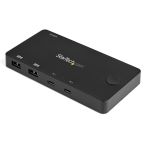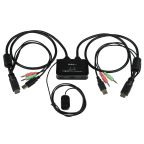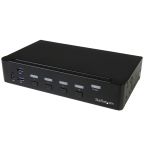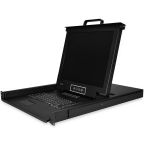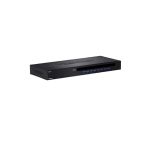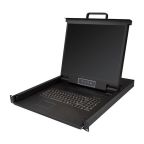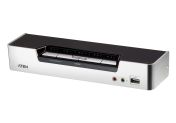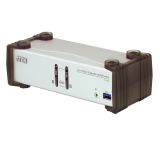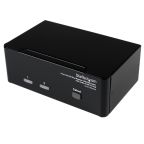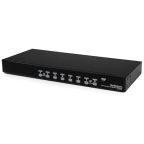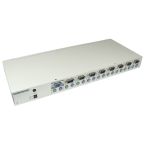KVM Switches
KVM switches are hardware devices which allow users to control multiple computers from a single set of peripherals. These peripherals include a keyboard (K), video monitor (V), and mouse (M). The primary function of KVM switches is to consolidate control into one workstation, simplifying management, reducing desk and rack clutter, and improve operational efficiency in multi-computer setups.
What Is a KVM Switch?
A KVM switch, short for keyboard, video, and mouse switch, is a hardware solution that enables seamless control of multiple computers from a single set of peripherals.
KVM switches in Malaysia are commonly used in data centres, server rooms, and control stations, allowing IT administrators, engineers, or operators to quickly switch between systems. Some models support access by multiple users, making it easier to share control over a group of computers in collaborative settings.
By streamlining control and reducing the need for duplicate hardware, KVM switches help improve efficiency, save space, and lower overall equipment costs, making them essential tools in any multi-system environment.
How Does a KVM Switch Work?
A KVM switch functions by routing input/output signals from multiple connected computers to a single set of peripherals. When a user selects a system to control, the switch establishes a direct connection, allowing for seamless interaction.
Switching between systems can be done in several ways, including via push buttons on the device, keyboard shortcuts (hotkeys), on-screen display (OSD) menus, or remote software interfaces.
Modern KVM switches often support additional functionality, such as sharing USB peripherals (like printers or storage devices), audio output, or even touchscreens across systems. Large-scale or enterprise-grade KVM switches can handle hundreds or even thousands of connected computers, with multi-user consoles and remote management capabilities, suitable for complex IT infrastructures.
When Are KVM Switches Used?
KVM switches support a wide range of use cases across both single-user and multi-user environments, including:
- Centralised Computer Management: A single KVM setup lets one user manage multiple machines without moving between separate workstations, ideal for setups like server rooms and test labs.
- Shared Access for Multiple Users: KVM Matrix switches support concurrent access, allowing multiple users to interact with different systems at once from their own terminals.
- Cross-Platform Switching: Easily toggle between systems running different operating systems, including Windows, macOS, and Linux, without the need for separate input devices.
Due to their versatility, KVM switches are used across industries such as IT services, broadcasting, government agencies, and financial institutions where rapid access to multiple systems is essential.
What Are the Different Types of KVM Switches?
KVM switches are available in various types, each designed to support specific video interfaces, connectivity options, and remote access capabilities.
DisplayPort KVM Switches
These switches are gaining popularity as video display manufacturers increasingly adopt DisplayPort technology. DisplayPort KVM switches facilitate high-definition digital video transmission and support peripheral sharing. They are well-suited for modern, high-resolution monitors and professional workstations demanding superior video quality and USB device integration.
DVI KVM Switches
DVI (Digital Visual Interface) KVM switches are designed for use with DVI-compatible monitors. They provide reliable digital video capabilities, overcoming the resolution limitations of older VGA formats. These switches can work with either single or dual-link DVI-D or DVI-I connections and often offer reverse compatibility, proving useful for users who need to manage high-performance workstations.
HDMI & USB KVM Switches
HDMI KVM switches are ideal for environments where video quality is critical such as broadcasting suites, medical imaging stations, digital signage, or professional AV setups. They offer high-resolution support and seamless HDMI signal switching.
USB KVM switches, the most widely used type, connect peripherals using standard USB interfaces and often support audio and wireless connectivity. Some models also retain PS/2 ports for legacy system support, making them a flexible choice for both modern and mixed-hardware workspaces.
KVM-over-IP Switches
KVM-over-IP switches provide users with the ability to access or monitor multiple PCs and servers over a dedicated network, a Local Area Network (LAN), or even a Wide Area Network (WAN) from any location with IP remote access. These are primarily found in medium to large data centres that require multiple users to monitor and control numerous computers or servers remotely.
Key Benefits of Using KVM Switches in Modern Workspaces
KVM switches help streamline control across multiple systems using just one set of peripherals. This brings several practical advantages:
- Space-Saving Setup: Reduces desk and rack clutter by eliminating the need for multiple keyboards, monitors, and mice.
- Cost Efficiency: Lowers hardware expenses and simplifying maintenance by cutting down on peripheral duplication.
- Improved Productivity: Enables seamless switching between systems, helping IT teams and power users work more efficiently.
- Centralised Control: Simplifies device management, especially in server rooms, data centres, or multi-system workflows, reducing physical movement and operational complexity.
- Reduced Downtime: Quick access to different machines allows for faster troubleshooting and system maintenance.
- Cross-Platform Compatibility: Supports switching between systems running different operating systems like Windows, macOS, and Linux.
Security Features and Best Practices for KVM Switches
KVM switches, particularly those managing critical systems, incorporate various security features:
- Authentication and Encryption: Many KVM switches offer robust authentication methods, such as user passwords and multi-factor authentication. Encryption protocols, especially with KVM-over-IP models, secure data transmission between the remote user and the controlled computers.
- Firmware Updates: Regularly updating the KVM switch's firmware is a vital security practice. Manufacturers frequently release updates to patch vulnerabilities, improve performance, and add new security features, protecting against evolving threats.
- Access Restriction: Implement strict access control policies. Only authorised personnel should have physical or network access to KVM switches. Use features like user permissions and activity logging to monitor and control who can access which computers.
Choosing the Right KVM Switch for Your Needs
Selecting the ideal KVM switch requires careful consideration of several factors to ensure it perfectly integrates with your setup:
- Number of Devices: Choose KVM switches capable of managing the total number of computers, from small 2- or 4-port desktop units to advanced enterprise-grade systems capable of handling hundreds of machines simultaneously.
- Connection Types: Identify the video output (e.g., HDMI, DisplayPort, DVI, VGA) and peripheral connections (e.g., USB, PS/2) on your computers and monitor. Ensure the KVM switch offers compatible ports.
- Operating System Compatibility: Verify the KVM switch is compatible with the operating systems running on your computers (Windows, Mac, Linux, etc.). Also, check for compatibility with specialised peripherals you might use.
- Extra Features: Consider additional functionalities like USB peripheral sharing (beyond keyboard/mouse), audio support, remote IP access, or hotkey switching for quick transitions.
- Workspace Requirements: Evaluate your physical space. A compact desktop KVM is ideal for a single workstation, while rack-mountable KVM-over-IP switches suit larger data centres.
Industrial Application of KVM Switches
KVM switches play a vital role in a wide range of industrial and mission-critical environments in Malaysia:
- Data Centres: KVM switches provide administrators with centralised control over numerous servers and network devices from a single console.
- Broadcast Stations: In broadcasting, KVM switches allow engineers and producers to manage multiple video servers, editing suites, and production computers from a single workstation.
- Control Rooms: KVM switches are fundamental in 24/7 control room environments. Operators can seamlessly switch between monitoring and controlling various systems, from power grids and traffic flows to security surveillance.
- Government Agencies: Government operations, including defence, public safety, and administrative departments, utilise KVM switches for secure and efficient access to multiple classified or unclassified computer systems.
- Telecommunications: In telecommunications, KVM switches are used to manage server farms, network equipment, and diagnostic workstations. They facilitate remote monitoring and maintenance of critical communication infrastructure.
- Financial Sector: KVM switches provide secure and rapid access to multiple trading platforms, data analysis terminals, and financial servers. This allows traders and analysts to manage complex real-time operations efficiently and securely.
How to Order KVM Switches from RS Malaysia
RS Malaysia is your dependable source for a wide selection of premium KVM switches from top brands such as Aten, StarTech.com, and Rextron. Explore our comprehensive online catalogue to find the ideal 2-port KVM switch dual monitor setup, network hub port, or network cable speed tester to support your IT infrastructure, streamline device management, and maintain optimal network performance.
When you’re ready to buy, simply add your chosen items to the shopping cart and proceed through our secure, user-friendly checkout process. We offer a variety of flexible payment options for your convenience. For detailed information on delivery schedules, shipping fees, and service coverage within Malaysia, please visit our Delivery Information page.
Popular Searches
Related links
- RS PRO 2 Port Dual Monitor USB HDMI KVM Switch
- NewLink 2 Port Dual Monitor USB DisplayPort KVM Switch, 3.5 mm Stereo 4000 Maximum Resolution
- Rextron 2 Port Dual Monitor PS/2 DVI-D KVM Switch
- NewLink 2 Port Dual Monitor USB USB 3.5 mm Jack
- Rextron 2 Port Dual Monitor PS/2 SVGA, VGA KVM Switch
- StarTech.com 2 Port Dual Monitor USB DisplayPort KVM Switch, 3.5 mm Stereo 3840 x 2160 Maximum Resolution
- StarTech.com 4 Port Dual Monitor USB DisplayPort KVM Switch, 3.5 mm Stereo 3840 x 2160 Maximum Resolution
- Rextron 2 Port Quad Monitor USB SVGA KVM Switch

